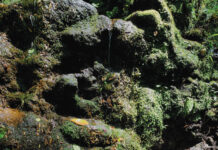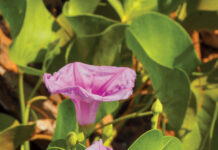“Poi represents the ancestors,” says Hailama Farden, a professor of Hawaiian language at Kamehameha School, Kapalama. “The poi is traditionally served in an ‘umeke, a communal bowl with a cover. When the lid is taken off, there’s no more grumbling at the family table”—the spirit of Haloa, ancestor of the Hawaiian people, is present.As Hawaiian culture and language continue their steady resurgence begun in the 1970s, an awareness of the importance of kalo is reemerging as well, strengthened by the efforts of Noho‘ana Farm and other family farms that involve the community in their success.
For the Pellegrinos, culture and raising kalo go hand-in-hand. “The main thing is trying to incorporate more of the kuana‘ike Hawai‘i (Hawaiian perspective) in the educational experience that we give,” Hokuao says. “It’s not just the planting and the harvesting, but we talk about the water [essential to productive lo‘i], traditional farming practices, Hawaiian terminology, the chants.”
Now that the sugar industry’s thirsty acres of cane are slowly fading from the Hawaiian landscape, families throughout the islands are fighting for long-diverted water to be returned to the lo‘i. For kalo to again reign in the valleys, it must be nurtured by the interest and understanding of the younger generation—an interest fueled by exposure.
“The first time we had a group up here, just to see a river flowing and taro patches up in Waikapu was exciting for them,” says Victor Pellegrino. “People don’t associate Waikapu with a taro-growing region, yet if you were to have gone up just 100 years ago, the valley would have been full.”
Hokuao says he sees increased interest in kalo farming among his peers. “A good 10 or 15 years ago, if you were to go to a kalo patch, the average farmer would be in their 60s or 70s,” Hokuao says. “Now you see the younger generation coming out . . . they’re starting to see the value of returning to the ‘aina [land].”
From its ‘oha, or offshoots, the kalo plant is reborn, generation after generation—replenishing the lineage that began with the elder brother of the Hawaiian people.





